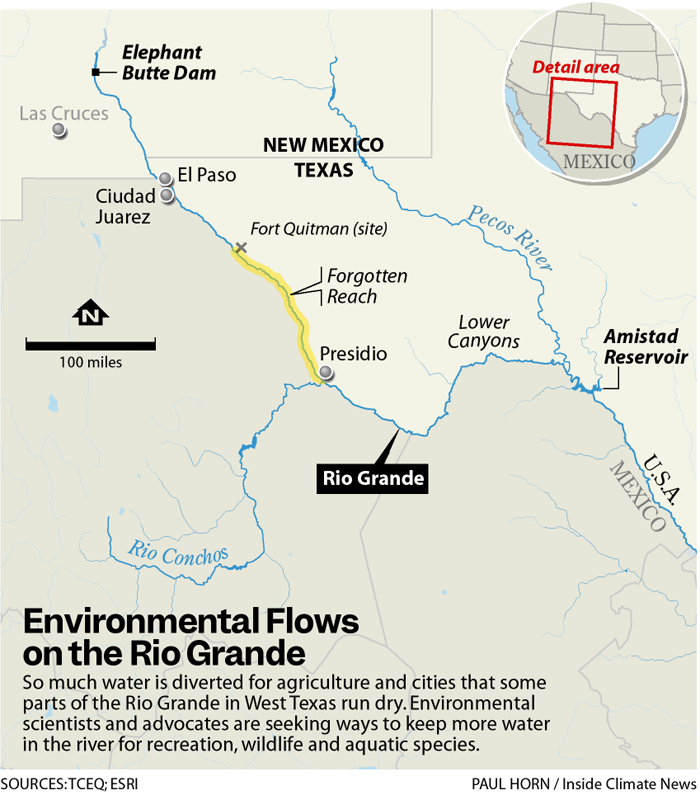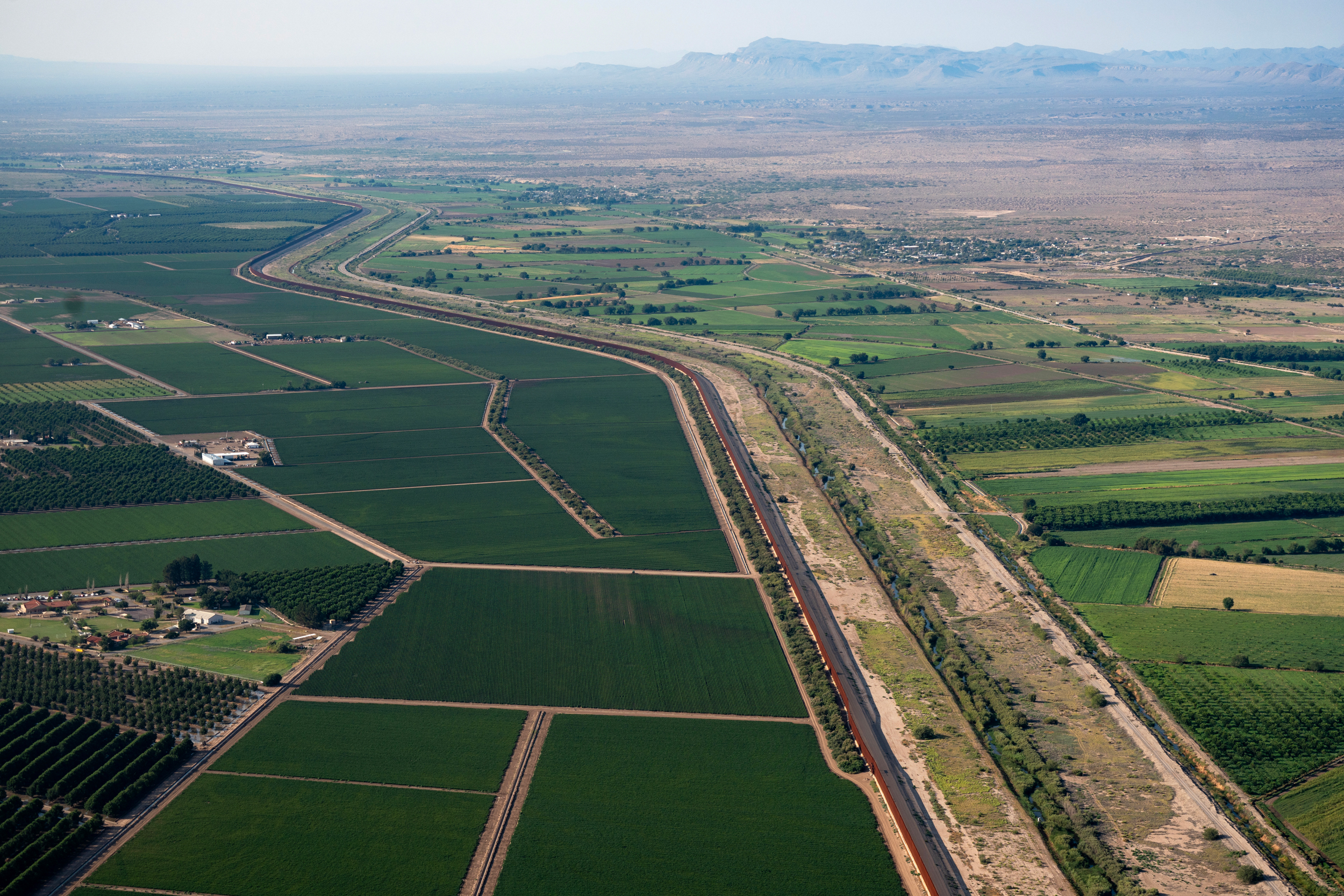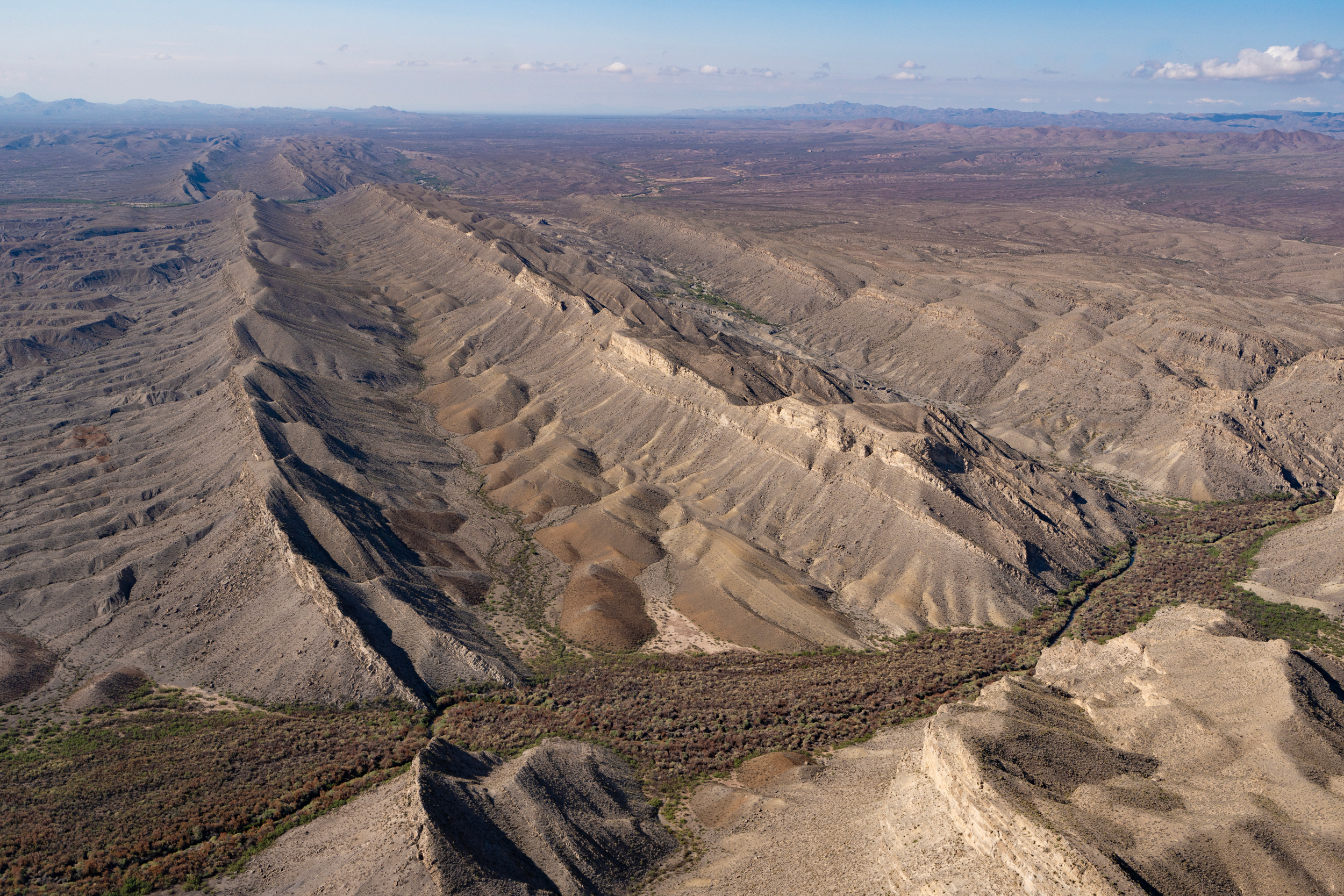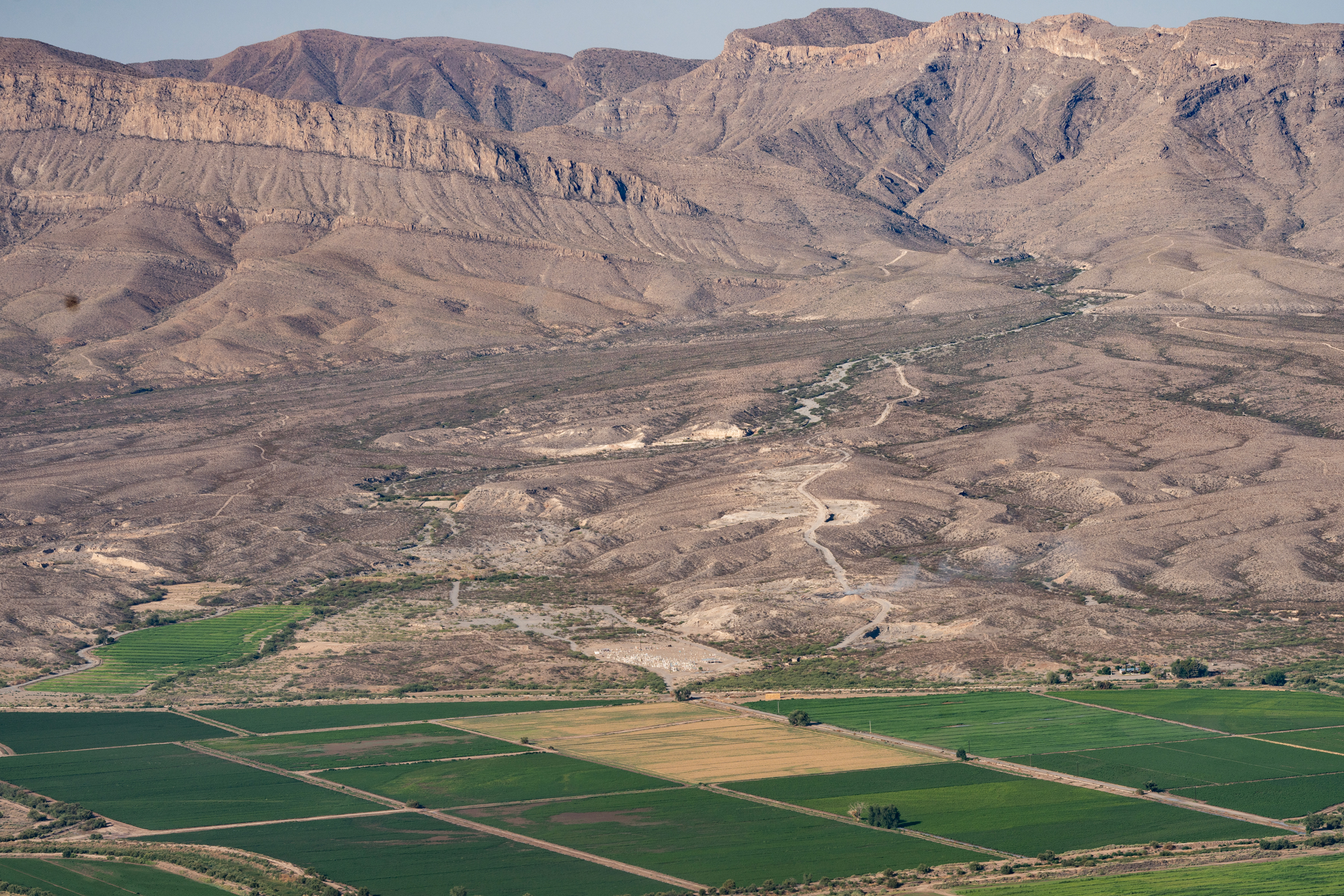Holding Out Hope On the Drying Rio Grande
Reporting supported with a grant from The Water Desk at the University of Colorado Boulder. Aerial photography support provided by LightHawk.
FAR WEST TEXAS—The year was 1897. Flood waters from the Rio Grande submerged entire blocks of downtown El Paso.
The New York Times described the crash of crumbling houses and the “cries of frightened women and children” on its May 26 front page. The raging river displaced hundreds of people and destroyed scores of adobe homes.
In Mexico, the Rio Grande is known as the Rio Bravo—the rough, or wild, river—signifying the force that caused several devastating floods in El Paso and neighboring Ciudad Juárez.
Today these historic floods are hard to imagine. The river channel in El Paso-Juárez now only fills during the irrigation season. Further downstream, the river is frequently dry in a 200-mile section known as the Forgotten Reach.
Explore the latest news about what’s at stake for the climate during this election season.
Inside Climate News documented this remote stretch of the river in July on a flight with the non-profit Light Hawk. Other than limited flows from springs and creeks, known locally as arroyos, this section of the Rio Grande barely has water.
That’s because reservoirs now harness the flows of snowmelt and monsoon rains that once defined the river and deliver that water to thirsty cities and sprawling farms. Making matters worse, climate change is increasing temperatures and aridification in the desert Southwest.
Competition over dwindling water is growing. All that leaves little water to support fish, birds and wetland ecosystems that once thrived along the Rio Grande.
But environmental scientists and local conservation advocates say there are opportunities to restore environmental flows—the currents of water needed to maintain a healthy river ecology—on the Rio Grande and its West Texas tributaries. Proponents of environmental flows are restoring tributaries and documenting little-known springs that feed the river. They are working with counterparts in Mexico to overcome institutional barriers.

Samuel Sandoval Solis, a professor of water resource management at the University of California Davis and an expert on the Rio Grande, compared this restoration model to a “string of pearls.”
“Ultimately, we start connecting these pearls,” he said. “And we start putting it back together.”
But to replicate and expand these local initiatives will require more funding and political support on the embattled binational waterway.
Water for Agriculture, but Not for Nature
For millions of years, the flow of the Rio Grande in present-day New Mexico and West Texas was dictated by two natural cycles. Spring snowmelt in Colorado sent water rushing downstream, triggering floods throughout the watershed. In the summer, the monsoon dumped rain on the desert and swelled the river.
These annual “pulses” of water sustained biodiverse ecosystems in the arid Chihuahuan Desert.
Karen Chapman, coordinator of the Rio Grande Joint Venture, a public-private migratory bird conservation partnership, said the Big Bend segment of the Rio Grande in West Texas is an “emblematic, important wetland for migratory birds in the middle of a big desert region.”
Floods spread the seeds of cottonwoods and tornillos, a native mesquite shrub. Thriving wetlands attracted the southwestern willow flycatcher. Floodplains provided spawning habitat for the Rio Grande cutthroat trout and silvery minnow. Indigenous people harnessed the water for subsistence agriculture.
These cycles came to an end in the early twentieth century. In 1916, the Bureau of Reclamation completed Elephant Butte Dam outside Truth or Consequences, New Mexico. Its 301-foot retaining wall captured the crush of water coming out of the mountains. The dam released water on a precise schedule for farmers farther down the river. The three cities immediately downstream—El Paso, Las Cruces and Ciudad Juárez—continued to grow.

The Rio Grande Compact—signed in 1938 between Colorado, New Mexico and Texas—sealed the river’s fate. The compact ensured that farmers in all three states would get their share of water. But there was no obligation to guarantee water flowed beyond the last irrigation district south-east of El Paso, at a point called Fort Quitman. The once-mighty Rio Grande began to dry up downstream of that now abandoned ghost town.
When seasonal flooding ceased in the Forgotten Reach, salt cedars and arundo river cane invaded the floodplain and crowded out native cottonwoods and tornillos. With meager volumes of water in the river, sediment has built up and further hampered the flow. Wetlands shriveled and migratory birds lost stop-over points.
“The river transforms from a natural flashy system to a straight ditch,” explains Kevin Urbanczyk, director of the Rio Grande Research Center at Sul Ross State University in Alpine, Texas. “You lose the aquatic habitat when that happens.”
The Forgotten Reach ends where the Rio Conchos flows from Chihuahua into the Rio Grande at Presidio, Texas. Before the construction of Elephant Butte, over 500,000 acre feet of water reached Presidio each year. After the construction of the dam, the flow fell by 77 percent, according to the Army Corps of Engineers.
In West Texas, the Rio Grande Joint Venture works with landowners to restore grassland and riparian habitats near Rio Grande tributaries like the Terlingua Creek and Alamito Creek. These projects reduce the amount of sediment reaching the Rio Grande, a key intervention to improve flow on the river.

In recent years, flows have also declined downstream of Presidio. Mexico is obligated under the 1944 water treaty to send water from tributaries, including the Conchos, to the United States on a five-year cycle. But since the 1990s Mexico has consistently fallen behind, diminishing water levels in the Rio Grande downstream of Presidio.
The river ran dry through the iconic Santa Elena Canyon in Big Bend National Park in 2022. Rafting expeditions, a bedrock of the Big Bend tourism economy, rely on a river that is less and less dependable.
What water Mexico does deliver is stored at the Amistad and Falcon Reservoirs in South Texas. The Texas Commission on Environmental Quality (TCEQ) then distributes water from the reservoirs to irrigation districts and cities in South Texas and the Rio Grande Valley.
This section of the Rio Grande is considered “over appropriated,” which means there are more assigned water rights than there is water normally available. In other words, every drop of water already has an assigned end-user. There is no water left over for dedicated environmental flows in South Texas.
The problem was abundantly clear in 2001, when for the first time in decades the Rio Grande failed to reach the Gulf of Mexico.
Advocating for Environmental Flows Across Borders
Conservation advocates and scientists working on the Rio Grande face formidable challenges: a binational treaty dispute, climate change, an over-appropriated river. But UC Davis’ Sandoval Solis is convinced environmental flows are possible if water is managed differently.
Sandoval Solis would like to see Mexico release water from its Rio Conchos reservoirs to the Rio Grande to mimic the cycles of spring floods and the summer monsoon. He said better timing of releases can help native species without infringing on farmers’ water rights.
He acknowledged that environmental flows are not a priority in ongoing diplomatic talks as the U.S. works to compel Mexico to release any water. But he said “pulses” of water at opportune times could go a long way.
The idea has already been implemented on the Colorado River, another binational river governed by the 1944 water treaty. In 2014, water was released from the Morelos Dam to create a pulse flow that connected the Colorado River to the Gulf of California for the first time in 16 years. In 2017, the U.S. and Mexican governments agreed to ongoing water deliveries for restoration of the Colorado River delta in Mexico.

U.S. International Boundary and Water Commission spokesperson Frank Fisher said “nature-based solutions” have been part of the agency’s discussions with Mexican counterparts, but did not indicate whether there is interest in a pulse flow on the Rio Grande/Rio Conchos.
In February, the U.S. IBWC and its Mexican counterpart, known as CILA, created the Rio Grande Environment Work Group. The group has met several times this year to identify and implement binational environmental projects on the Rio Grande.
Karen Chapman of the Rio Grande Joint Venture advocated for the creation of the working group and is now a member. “There are folks on both sides of the river in both countries that are concerned about the health of the river and want to work towards some solutions,” she said.
There have been some successes in restoring flows to the Rio Grande. In a 2022 paper in Ecology & Society, Sandoval Solis and colleagues at UC Davis and the University of Oklahoma compiled examples of environmental flows throughout the Rio Grande/Rio Bravo watershed. They point to in-stream flows on Rio Grande tributaries in New Mexico and the first environmental water right in Mexico at the Cuatro Ciénegas wetlands as models to replicate.
A 2023 paper published in the Journal of Water Resources Planning and Management, by lead author Brian Richter of Sustainable Waters, with Sandoval Solis as a co-author, expanded on these ideas. The authors model how converting farmland to less water-intensive crops and leaving some acreage fallow could decrease consumption in agriculture, which currently uses 83 percent of the water rights in the watershed. This would make more water available for environmental flows, without reducing agricultural revenue.
Sandoval Solis said politics is getting in the way of expanding on these models to restore flows to the river.
“The problem of environmental flows on the Rio Grande is not about science,” he said. “We know that the river is drying and we know that it’s about willingness, political willingness.”
Protecting Groundwater that Feeds the Rio
Sul Ross’ Kevin Urbanczyk studies the Lower Canyons on the Rio Grande, downstream of Big Bend. At least once a year he loads up a canoe to reach the canyons, which are not accessible by road, where he measures the flow from aquifer-fed springs into the river.
Urbanczyk said that when Mexico does not send water from the Rio Conchos, all the water in this section of the Rio Grande comes from the springs. He said more research is needed to understand how groundwater contributes to the Rio Grande.
Texas has two separate systems to regulate surface water in a river and groundwater in aquifers. But Urbanczyk said regulations need to account for how these sources are interconnected. He worries that an increase in groundwater pumping near the river could deplete the springs’ contributions to the Rio Grande.
“We’re talking… as if they’re two different things,” he said. “But they’re not. It’s the same water, so the connection needs to be understood.”
The IBWC spokesperson said that historic water gauge data and field studies indicate that groundwater amounts to a discharge of approximately 200 cubic feet per second in the Big Bend region to the Amistad Reservoir.
“[IBWC] understands the importance of these groundwater contributions to providing reliable and predictable water supply to downstream users as well as sustaining environmental processes in the region,” said the spokesperson.
Environmental Flows Legislation in Texas
Largely absent from the discussion of environmental flows on the Rio Grande is the Texas legislation meant to achieve that very objective. In 2007, the Texas Legislature passed Senate Bill 3, which provides protections for environmental flows in Texas rivers and into bays and estuaries.
However, TCEQ excluded the Forgotten Reach from the environmental flows program for the Rio Grande from the outset. The Forgotten Reach would stay forgotten—there would be no environmental flow protections in this 200-mile long stretch of the river.
But in a 2008 study with the Army Corps of Engineers, TCEQ expressed interest in restoring the Forgotten Reach. The study explored restoration options and stated that “The ‘Forgotten’ Rio Grande might have great value as a laboratory for the art and science of rehabilitating perturbed rivers.”

The TCEQ declined a request for an interview about the environmental flows program. In an emailed statement, TCEQ spokesperson Victoria Cann did not respond to questions about why the agency excluded the Forgotten Reach from the program.
The TCEQ formed a scientific working group, including academics and civil society representatives, that recommended environmental flow regimes for the Rio Grande basin. TCEQ then formalized flow standards for the Rio Grande which were adopted into the state administrative code. However, a brief from the Texas Living Water Project points out that the standards TCEQ adopted were a far cry from what the scientific working group recommended.
Myron Hess, a water lawyer and consultant with the Texas Living Waters Project, authored a 2021 report on the “unrealized potential” of Senate Bill 3. The report states that efforts to revive environmental flows have “stalled” in most river basins. Hess said that the models to calculate environmental flow standards do not account for climate change, which is expected to diminish water resources in central and west Texas.
“As droughts get more severe there is going to be less and less water available to protect the environment,” he said. “It’s going to be a world of hurt.”
The TCEQ spokesperson did not respond to multiple requests for comment about the exclusion of climate change from the models. She said that the adopted standards can be revised if new information and data becomes available.
UC Davis’s Sandoval Solis characterized the Texas legislation as “a check box” for regulators to complete. He said the studies commissioned by the legislature have not been acted on.
“In the end you use those studies to do nothing,” he said. “You don’t have any teeth to enforce and to put some water in [the river].”
Despite the setbacks, Sandoval Solis still believes that flows can be restored to the drying Rio Grande. Human intervention over the past 130 years has dramatically transformed the river and stymied its natural flow. But even in the face of climate change he maintains that it’s not too late to reverse some of these changes.
“The river is very forgiving,” he said. “When we have seen the full river coming back to life… in a monsoon, in a hurricane… to me that’s been a very happy experience.”
About This Story
Perhaps you noticed: This story, like all the news we publish, is free to read. That’s because Inside Climate News is a 501c3 nonprofit organization. We do not charge a subscription fee, lock our news behind a paywall, or clutter our website with ads. We make our news on climate and the environment freely available to you and anyone who wants it.
That’s not all. We also share our news for free with scores of other media organizations around the country. Many of them can’t afford to do environmental journalism of their own. We’ve built bureaus from coast to coast to report local stories, collaborate with local newsrooms and co-publish articles so that this vital work is shared as widely as possible.
Two of us launched ICN in 2007. Six years later we earned a Pulitzer Prize for National Reporting, and now we run the oldest and largest dedicated climate newsroom in the nation. We tell the story in all its complexity. We hold polluters accountable. We expose environmental injustice. We debunk misinformation. We scrutinize solutions and inspire action.
Donations from readers like you fund every aspect of what we do. If you don’t already, will you support our ongoing work, our reporting on the biggest crisis facing our planet, and help us reach even more readers in more places?
Please take a moment to make a tax-deductible donation. Every one of them makes a difference.
Thank you,
David Sassoon
Founder and Publisher
Vernon Loeb
Executive Editor
Share this article
- Republish
Disclaimer: The copyright of this article belongs to the original author. Reposting this article is solely for the purpose of information dissemination and does not constitute any investment advice. If there is any infringement, please contact us immediately. We will make corrections or deletions as necessary. Thank you.
Title:Holding Out Hope On the Drying Rio Grande
Url:https://www.investsfocus.com






